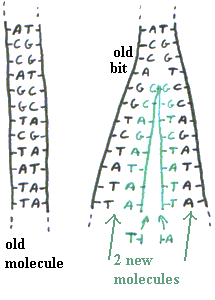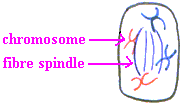Le coin des amatheurs de sciences version 2 
The sections of the site : The site  FORUM
FORUM  The space
The space  The genetics
The genetics  Medicine
Medicine  Physics
Physics  Tintin and science
Tintin and science  Ecology - Nuclear energy
Ecology - Nuclear energy  Mysteries of the history
Mysteries of the history  Humour
Humour  Diverse
Diverse
Le coin des amatheurs de sciences version 2 
The sections of the site : The site  FORUM
FORUM  The space
The space  The genetics
The genetics  Medicine
Medicine  Physics
Physics  Tintin and science
Tintin and science  Ecology - Nuclear energy
Ecology - Nuclear energy  Mysteries of the history
Mysteries of the history  Humour
Humour  Diverse
Diverse
To understand this page, you should firstly read : Bases of the genetics, The synthesis of proteins.
All our cells contain the same genetic program, that of the egg-cell resulting from the fusion of a spermatozoon and an ovule. How the cells can keep same information when they divide ?
For the knowledge, it is initially necessary to study how the cells divide, and how genetic information is transmitted.
The replication of the DNA
 This mechanism is very simple, and is authorized by the complementarity of the nitrogenized bases. A molecule of DNA is retorted as follows : The two bits are drawn aside by a rupture of the connections between nitrogenized bases. Then nucleotides are set up in front of those of the DNA, by respecting the complementarity, and one finds two molecules of DNA identical to old.
This mechanism is very simple, and is authorized by the complementarity of the nitrogenized bases. A molecule of DNA is retorted as follows : The two bits are drawn aside by a rupture of the connections between nitrogenized bases. Then nucleotides are set up in front of those of the DNA, by respecting the complementarity, and one finds two molecules of DNA identical to old.
The mitosis
On the level of the cell, there are four phases. However, the mitosis (i.e. the mechanism of unfolding of the cells) is a continuous phenomenon, and the 4 phases are arbitrarily defined.
The prophase
 The genetic material of the cell condenses, forming short and thick sticks : chromosomes. This condensation makes it possible the chromosomes to be disentangled to separate more easily. The envelope of the core disappears and one sees appearing a fibre spindle.
The genetic material of the cell condenses, forming short and thick sticks : chromosomes. This condensation makes it possible the chromosomes to be disentangled to separate more easily. The envelope of the core disappears and one sees appearing a fibre spindle.
The metaphase
 The chromosomes gather, their centromeres being placed in the équatorrial plan of the spindle
The chromosomes gather, their centromeres being placed in the équatorrial plan of the spindle
The anaphase
 The centromeres are divided into two and the chromatides of each chromosome separate then migrate towards the poles of the spindle. Thanks to the replication of the DNA, both chromatides of a chromosome is identical. Thus, the two batches formed during the anaphase are identical.
The centromeres are divided into two and the chromatides of each chromosome separate then migrate towards the poles of the spindle. Thanks to the replication of the DNA, both chromatides of a chromosome is identical. Thus, the two batches formed during the anaphase are identical.
The telophase
 The chromosomes gather with the poles and are uncondensed. ,The spindle disappears and of the nuclear envelopes reform each side. The cytoplasm is divided into two, the cells separate.
The chromosomes gather with the poles and are uncondensed. ,The spindle disappears and of the nuclear envelopes reform each side. The cytoplasm is divided into two, the cells separate.